Top News
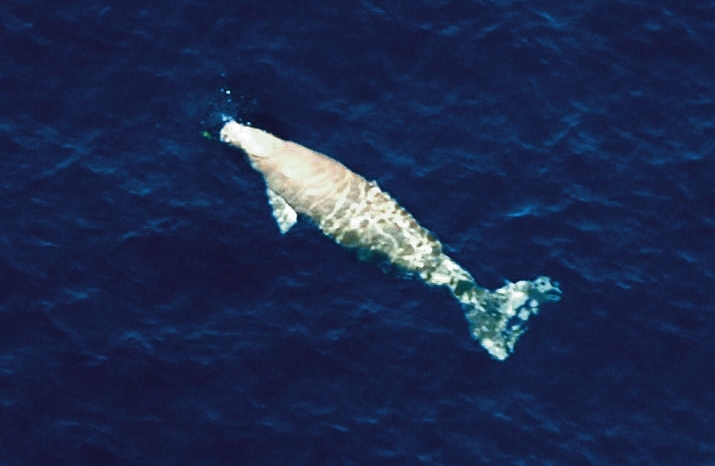
December 3, 2018 Ryukyu Shimpo
By Yuri Shimizu and Akira Manato
A dugong (specimen A) known to inhabit the waters off of Kayo near the construction site of the Futenma Replacement Facility (FRF) in Henoko, Nago City, has not been spotted in over two months. On November 28 the Okinawa Defense Bureau (ODB) reported this at a meeting of the Environmental Oversight Committee. The ODB reported not noticing construction affecting the dugongs, due to traces of dugong grazing observed in the seaweed beds where they feed. An expert speculated, “Won’t they come at night to feed, since the construction is noisy during the daytime so they cannot live in Oura Bay?”
In Okinawa three dugongs (specimens A, B, and C) have been confirmed within the last 15 years or so, but since construction started two of these specimens have not been spotted. This will likely become a new basis for Okinawa’s argument that FRF construction affects the environment, which Okinawa employs in its confrontation with Japan concerning revocation of the land reclamation permit.
Right after construction in Henoko commenced specimen C went missing. In August, the Okinawa Prefectural Government (OPG) used the disappearance of specimen C as one of its reasons for revoking the land reclamation permit.
Upon receiving word that specimen A could not be located, the OPG’s Henoko Base Construction Countermeasures Division made the statement, “The prefecture’s claim is being substantiated further.” The division also expressed awareness that when the OPG goes to court over revocation of the land reclamation permit, the missing dugongs will be used as a factor in the OPG’s argument about the importance of stopping construction in Henoko.
However, the ODB does not recognize that the lack of dugong sightings is due to construction. In response to an inquiry from the Ryukyu Shimpo, the ODB stated that a survey in the Kayo sea area showed 25 signs of feeding in October and 17 signs of feeding in November, and explained on this basis that “The dugong is using the feeding grounds.”
The ODB stated that the results of the dugong call survey it is conducting in addition to the feeding survey are still undergoing analysis, and emphasized that “At Environmental Oversight Committee meetings, committee members advise us that it is necessary to consider the matter comprehensively based on all survey results.”
However, Director Taro Hosokawa of the Dugong Network Okinawa feels dread for the dugongs. He pointed out that in ODB surveys up to this point specimen A’s habitat was said to be moving gradually out to sea and away from the land reclamation area. Hosokawa suggested, “Isn’t it taking refuge away from Kayo due to the construction noise during the day?” Compared to the other two dugongs, specimen A seems intent on inhabiting the waters off of Kayo. If it strays too far into unfamiliar waters there is concern that it could be caught in fishing waters.
Hideki Yoshikawa, who aids the dugong lawsuit in the United States, views it as problematic that the environmental impact assessments performed by the US military and ODB recognized that there were dugongs living in the Kayo waters and that they still assessed, “Construction will not affect them.” Due to how the dugongs disappeared once construction began, Yoshikawa expressed his intent to substantiate this as a claim in the lawsuits concerning land reclamation permit revocation and the dugongs.
(English translation by T&CT and Erin Jones)
Go to Japanese
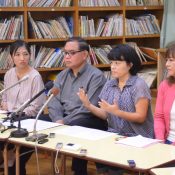
December 1, 2018 Ryukyu Shimpo
Parents from Midorigoaka Preschool (Nodake, Ginowan), where last year an incident wherein a piece from a U.S. military helicopter fell and landed on the school occurred, have formed a group dubbed “Team Midorigaoka 1207” and released a statement at a press conference held at the preschool November 30 demanding the right to vote on the referendum in Okinawa on whether or not to allow land reclamation in Henoko, Nago. The group is raising its voice as it has now become unclear if the vote is going to be carried out in Ginowan. After the press conference, the statement was sent to Ginowan Mayor Masanori Matsukawa and City Council Chairman Yasuyuki Uechi.
A position document opposing the referendum submitted by the city council’s ruling party at the December regular meeting directly references the incident at Midorigaoka preschool and stated, “ We cannot allow the result of the vote anchor Futenma [in its current location].” The statement released by the parent’s group indicated, “We are thankful for the statement having been made with the school in mind, however it is for that very reason that we cannot rob the citizens of Ginowan their right to vote on this matter.”
School Principal Takehiro Kamiya also commented on his point of view, saying, “The thought, ‘Do not fly over our school,’ is not about waiting for the new base facilities at Henoko to be built, or about a mere policy decision to either “relocate to Henoko,” or “keep Futenma in place,” but rather a desire [for those in power] to face a situation where the respect for life is being neglected.” At the press conference, in addition to the members from Team Midorigaoka, parents from all over the prefecture were in attendance. Comments from those in attendance included, “Does the city or city council even have the right to rob its citizens of the right to vote?” and “If [the vote] is rejected in Ginowan it will be rejected everywhere.”
(English translation by T&CT and Sam Grieb)
Go to Japanese
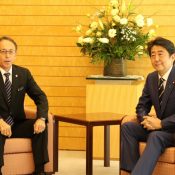
November 28, 2018 Ryukyu Shimpo Digital Edition
In the afternoon of November 28, Governor Denny Tamaki met with Prime Minister Shinzo Abe at the prime minister’s official residence to discuss the new base construction in Henoko, Nago City in association with the relocation of the U.S. military Futenma Air Station. During the meeting, the governor requested the suspension of the land reclamation construction for the new base. Prime Minister Abe expressed his opinion of continuing with the construction by saying, “This plan has been in place with the U.S. for quite some time now.”
This meeting, which marked the conclusion of intense negotiations that began with Governor Tamaki’s proposal, ended without reaching an agreement. Governor Tamaki plans to petition the Central and Local Government Dispute Management Council, which objects the Minister of Land, Infrastructure and Transportation’s decision to reinstate the land reclamation construction.
(English translation by T&CT and Chelsea Ashimine)
Go to Japanese
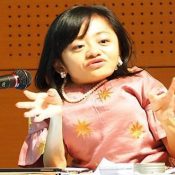
November 18, 2018 Ryukyu Shimpo
On November 17 at Urasoe City Tedako Hall a forum was held for a project promoting a barrier-free, livable society regardless of disability.
Columnist Natsuko Izena gave a lecture themed, “What does it mean to help each other?”
Izena said, “People with disabilities are not people who receive assistance; everyone helps each other.”
More than 200 people attended the forum.
Izena talked about her own experiences including life in a wheelchair, child rearing with ten assistants, and studying abroad.
She stressed that what is necessary for people with disabilities to be able to live just like anyone else is “reasonable accommodation.”
Additionally, she said that people who seem to act independently are still assisted by things that they can rely on and use.
She mentioned, “I wish there were more options for people with disabilities.”
In a subsequent panel discussion Izena and Koji Maekawa, a teacher at a special-needs school, discussed raising children with disabilities and child rearing for people with disabilities.
Maekawa talked about choices for students with disabilities.
He said, “I would like to respect and support the student’s wishes on how he/she wants to live while taking the parents’ thoughts into consideration.”
Keiko Ura, who attended from Urasoe City, said, “Although ‘reasonable accommodation’ sounds difficult, I understand that it means to consistently act with awareness.”
(English translation by T&CT and Megumi Chibana)
Go to Japanese

November 29, 2018 Ryukyu Shimpo
Okinawa Governor Denny Tamaki disclosed November 28 that during intense budget negotiations with the Japanese government, officials said the construction costs for land reclamation activities in Henoko, part of the new base construction for the relocation of MCAS Futenma, has expanded to 2.55 trillion yen.
The total cost of the levee construction is now 10 times that of the original budget, and the Ministry of Defense (MoD) disclosed in a budgetary planning document that the cost of land reclamation is also going to be 10 times that of the original 240 billion yen.
Furthermore, the budget for the expansion of MCAS Iwakuni also increased due to construction costs for improving infirm ground and for transporting additional sand and dirt from outside Okinawa.
The total construction time has also been indicated as 13 years; 5 years for land reclamation, 5 years for improving soft ground, and three years for facility construction after land reclamation is complete.
The Prefectural Office has demanded that the Japanese government explore policies other than the relocation to Henoko, stating, “Are we really going to continue with the plan that not only will not remove the danger of MCAS Futenma as soon as possible, but now will also cost over two trillion yen?”
The relationship between the construction costs and Okinawa’s budget is an approximated hypothesis to reinforce Okinawa’s claim, and not a public inquiry.
(English translation by T&CT and Sam Grieb)
Go to Japanese
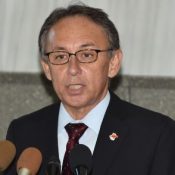
November 27, 2018 Ryukyu Shimpo online edition
On November 27 at 3:30 p.m. at the Prefectural Office, Okinawa Governor Denny Tamaki made an official announcement about the prefectural referendum that will ask Okinawans whether they support or oppose the Futenma replacement facility being constructed in Henoko, Nago City. He said that the date of the referendum is February 24 next year.
Notification of the referendum will be posted ten days prior to that date on February 14.
Governor Tamaki said, “This will be an extremely important opportunity, as Okinawans’ intentions could be directly reflected by the referendum.
I sincerely ask from the bottom of my heart that everyone please participate in the referendum and demonstrate their intent.”
In addition to calling for Okinawans to participate in the referendum, he asked for the cooperation from all municipalities’ village heads, mayors, and assemblies in conducting the referendum in all villages, towns and cities.
Signatures from 92,848 Okinawan citizens were collected requesting enactment of an ordinance for this referendum.
The governor of Okinawa signed off on it, and the Prefectural Assembly established the referendum ordinance on October 26.
Voters will be able to select from two options, whether they “support” or “oppose” Henoko land reclamation.
(English translation by T&CT and Erin Jones)
Go to Japanese
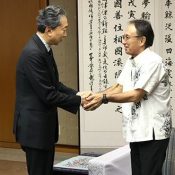
November 23, 2018 Ryukyu Shimpo
On November 22 for the first time since taking office, Okinawa Governor Denny Tamaki had an interview with former prime minister Yukio Hatoyama at the Prefectural Office.
In regard to construction of the Futenma Replacement Facility in Henoko that Governor Tamaki opposes, Mr. Hatoyama said, “It will be a considerably harsh battle, but I hope that you will persevere in your intent to absolutely not allow the new base to be built.”
Aside from the outset of the interview, their meeting was private. According to former prime minister Hatoyama after the interview, Governor Tamaki should “absolutely” block construction of the Henoko base.
He also encouraged Governor Tamaki to “fight to the very end.” Mr. Hatoyama also touched on Governor Tamaki’s first visit to the United States.
He shared his thinking that: “Your lecture in New York was received favorably. From here on, too, continue making efforts like visiting and asking the United States for its understanding.”
In the interview Mr. Hatoyama said that during his time as prime minister he set out to at least get a site for the Futenma Replacement Facility outside of Okinawa. He continued, “Now I think it should be relocated outside of Japan, and I believe that even Tokuno Island has proven troublesome [as a proposed relocation site].”
(English translation by T&CT and Erin Jones)
Go to Japanese
Satoko Oka Norimatsu, Editor, The Asia-Pacific Journal: Japan Focus
BTS (Bangtan Boys) is a seven-member hip-hop boys’ group that debuted in South Korea in 2013. Over the past two years, these top K-pop stars propelled themselves to worldwide stardom rapidly with their superb dancing, singing and visuals and their message that youth identify with, and SNS-based marketing.
Two of their albums earned a top Billboard spot just this year. Being Asian myself, I felt pride that Asian artists singing in their native language had achieved such remarkable success on a global scale.
Therefore, I was surprised when a friend told me this November that the internet was in an uproar over one of the BTS members having worn a T-shirt depicting an atomic bomb mushroom cloud.
Soon news hit that TV Asahi had decided to cancel a BTS performance scheduled for November 9 on their music program “Music Station” because of the T-shirt design in question.
Are Japanese people really so sensitive when it comes to the devastating effects of the atomic bomb?
If so, I wondered, why do they readily allow TV appearances by those government officials who support nuclear armament and refuse to sign the Treaty on the Prohibition of Nuclear Weapons?
However, the real problem lies elsewhere.
This issue arose while the Japanese government and Japanese media were in the midst of a massive-scale anti-Korea bashing campaign in response to an October 30 ruling by South Korea’s Supreme Court ordering the Japanese company Nippon Steel & Sumitomo Metal to pay reparations to former draftees in their employment who were forced to work under an inhumane and unlawful conditions.
People associated with xenophobic groups engaging in hateful actions against Koreans living in Japan instigated protest against BTS as “anti-Japan” to television stations and program sponsors.
In fact, the T-shirt in question has the National Liberation Day of Korea–the day on which Korea was freed from 36 years of colonial rule by Japan–as its theme, and a photograph of the atomic bomb is shown in one corner.
Some might indeed find this problematic, but to many Asians, not just Koreans, the memory of the “liberation” that occurred on August 15 is inseparable from the memory of the atomic bombings that immediately preceded it.
The image of the atomic bombing is, for Koreans, understood in the context of the overarching event of “liberation” following a history of colonial rule, and for Japanese people to point to just one part of the image and call it an “atomic bomb T-shirt” is to erase the history of Japan’s infliction of harm leading up to the atomic bombing.
BTS were subsequently taken to task for another one of their members having once worn a hat depicting a Nazi symbol and for having carried flags evoking Nazi imagery at their concerts.
The Simon Wiesenthal Center (SWC), an organization that monitors antisemitic activity, launched a protest, calling on BTS to apologize to Japanese people and those who suffered under the Nazis.
In response, on November 13, BTS’s agency issued an apology to SWC and to groups representing victims of the atomic bomb in Japan and South Korea.
I am in Hiroshima every year on August 6, and the aforementioned xenophobic group makes a point of assembling in Hiroshima on this day of mourning to blast their message advocating nuclear armament.
In fact, after the death of Keiji Nakazawa, author of the harrowing atomic bomb-themed manga “Barefoot Gen,” it was this group that launched a movement calling for the manga to be removed from public library shelves.
Regarding the Nazi issue, BTS issued an apology explaining that a proper check was not implemented on the design of the hat, which was worn at a magazine photoshoot.
Regarding the flags held at their concert, no Nazi symbol was used, and the band was singing a song expressing resistance to South Korea’s rigid educational system.
The band was putting on a performance to criticize totalitarianism, as in the case of an actor playing a Nazi in a war film wearing a Nazi uniform.
Those who alerted SWC to the performance without explaining the context were likely motivated more by anti-Korean sentiment than by concern for human rights.
While it’s true that there was carelessness on the part of BTS, the essence of the uproar can’t be grasped without an understanding of the existence of xenophobic people who even today hold a colonialist mentality and will exploit any means to bash Korea.
Groups like this one have been involved in hateful activities against Okinawa as well.
It must be remembered that the violent actions and words of such groups and individuals are escalating against a backdrop of the Japanese government itself engaging in discrimination against Korean schools, denial of the coercive nature of the Japanese military “comfort women” system, denial of the history of forced labor, and other “government-led hate.”
This is an English translation of Satoko Oka Norimatsu’s article series Norimatsu Satoko no me [Norimatsu Satoko’s Eyes] that appeared on Page 3 of Ryukyu Shimpo, November 19, 2018 edition.
Go to Japanese
November 27, 2018 Ryukyu Shimpo
Special correspondent Yukiyo Zaha reports from Washington DC
On November 26, the Ryukyu Shimpo learned that although the total number of U.S. military installations outside of the United States has decreased more than 30 percent from 761 installations in the last ten years, U.S. military installations in Japan have decreased by only three. According to the base structure report compiled by the U.S. Department of Defense for the U.S. 2018 fiscal year (October 2017 to September 2018), there are currently 514 overseas U.S. military installations in 45 countries, a reduction of 247 from the 761 installations present in 2008. Among those, at least 13 of the 23 overseas U.S. Marine Corps bases are in Okinawa. Okinawa’s U.S. base burden is brought into sharp relief once again against a backdrop of U.S. base closures worldwide.
There were more than 2,000 overseas U.S. bases in 1945, but after the end of the Vietnam War and the Cold War, this number trended downward. The U.S. carried out reduction and realignment of unnecessary bases at home and overseas with the aim of increasing efficiency of military installation operations, and after a major reduction in the defense budget in 2015, the DoD announced a realignment plan that involved consolidating U.S. military installations in the U.K., Germany, Belgium, and other parts of Europe.
In fiscal 2018, the country having the largest number of U.S. military installations was Germany at 194, followed by Japan at 121 and South Korea at 83. There has been a reduction of 74 installations in Germany and four installations in South Korea over the last ten years.
Of these overseas U.S. military installations, 202 are Army bases (a reduction of 125 since 2008), 166 are Air Force bases (a reduction of 93), 123 are Navy bases (a reduction of 26), and 23 are Marine Corps bases (a reduction of 3).
In 2008, overseas U.S. Marine Corps installations numbered 24 in Japan (including 15 in Okinawa, two at Camp Fuji, two at Iwakuni, and five undisclosed), one in South Korea, and one in Kenya. In 2018, these installations numbered 22 in Japan (13 in Okinawa, one at Fuji, one at Iwakuni, and seven undisclosed) and one in South Korea; this is a reduction of only three installations, with the majority still concentrated in Okinawa.
The 2018 report explains, “With the increased focus on reducing the federal government’s real estate footprint, DoD…has worked aggressively to not increase infrastructure square footage from a baseline established in 2015.”
(English translation by T&CT and Sandi Aritza)
Go To Japanese
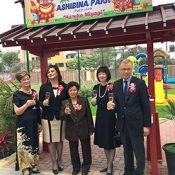
November 26, 2018 Ryukyu Shimpo
By correspondent Mitsuhiro Akamine
The Okinawa Association of Peru (AOP – Spanish: Asociación Okinawense del Perú) opened a children’s playground named “Ashibina Park” on the grounds of their community center in the suburbs of Lima on November 3. The same day, the group held an opening ceremony where Japanese Ambassador to Peru Sadayuki Tsuchiya, AOP president Maria Luisa Kohatsu, Okinawa Women’s Association (AFO – Spanish: Asociación Femenina Okinawense del Perú) president Eiko Okugi, and AFO advisor Haruko Miyagi cut the ceremonial tape, celebrating the completion of a dream they had held for many years.
At the ceremony, AOP president Kohatsu said, “We completed this fantastic playground with the warm support of everyone here. Next, we will celebrate the 40th anniversary of the founding of the AFO, and add two play structures and artificial grass, and give our deep gratitude for the use of this land.”
Ashibina Park covers 400 square meters of land behind the AOP community center, and is already equipped with four large and two small play structures. There is also in place a strip of artificial grass in the spacious play area, and it is expected to be a place to nurture the dreams of children. The playground was constructed for the sake of AOP member families, however the park is also open to non-members for a fee.
The construction cost of Ashibina Park was 60,000 dollars. Beginning with the AFO, four savings associations, companies owned by Okinawan-Peruvians, and AOP members, contributions were also gathered from the Okinawa-based Kanehide Holdings Co. Ltd., the Okinawa-Peru Association, and other individual donors.
(English translation by T&CT and Sam Grieb)
Go To Japanese
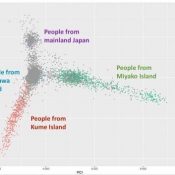
November 21, 2018 Ryukyu Shimpo
A research team under Professor Shiro Maeda of the University of the Ryukyus Graduate School of Medicine made public that when compared genetically, people from Okinawa have a different genetic background than Japanese people from mainland Japan. Even within Okinawa, each region has several hereditary groups. Researchers are coming to understand how genetics affect a person’s susceptibility to illness and the efficacy of medicine. With further discoveries, medical treatments and preventative techniques could become personalized to the individual.
The team conducted medical evaluations on consenting participants in the study, and collected samples such as blood and saliva. They then analyzed all genetic data collected including genome DNA. This study is part of the prefectural Promotion Project for Implementation of Leading Edge Medical Treatment that was started in 2016. Over 10,000 participants have cooperated in the project. The genome data is anonymous and is collected alongside medical information, for the purpose of understanding how genetics relates to illnesses experienced and efficacy of medical treatments.
A human genome contains about 3 billion base pairs, 99.7 percent of which are common among all humankind. Only about 0.3 percent or 10 million base pairs vary, which are called SNPs (standing for “single nucleotide polymorphisms,” and pronounced “snips”). When the team analyzed the SNPs of 4015 participants, it was able to differentiate genetic groups among residents of Okinawa Island, Kume Island, and Miyako Island.
Furthermore, the team confirmed the birthplaces of particpants’ grandparents for data on Kume Island and Miyako Island residents. If the data concerning residents of one island was considered separately, the dispersion of SNP data decreased and seemed to amass into one hereditary group.
Professor Maeda said, “I did not expect for the differences to be defined by region. It is important to separate by region upon conducting detailed analysis.”
(English translation by T&CT and Erin Jones)
Go To Japanese









 Webcam(Kokusai Street)
Webcam(Kokusai Street)


